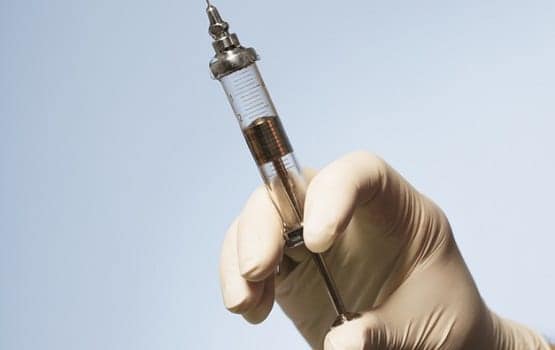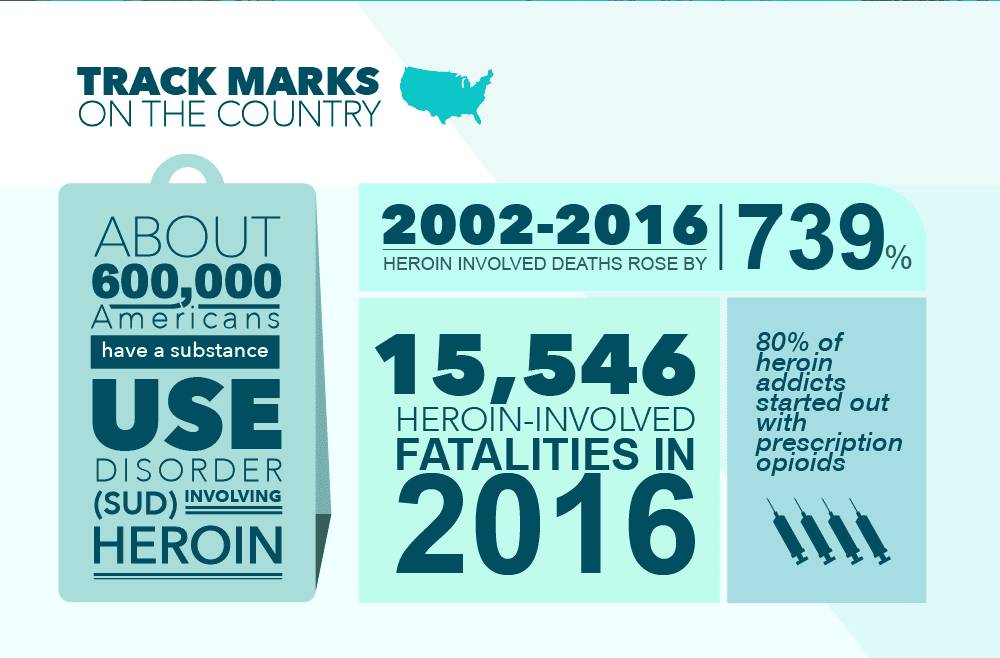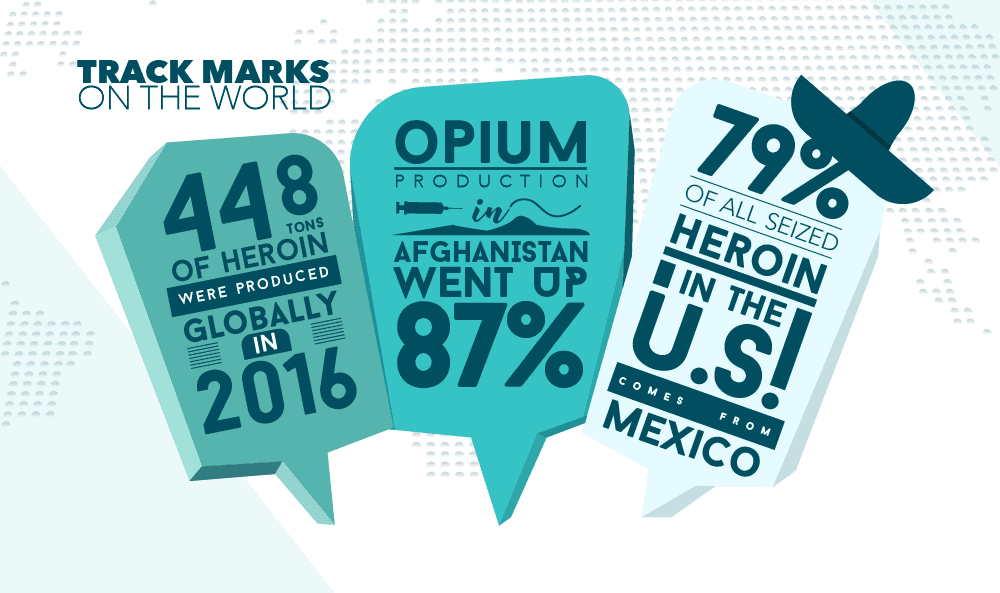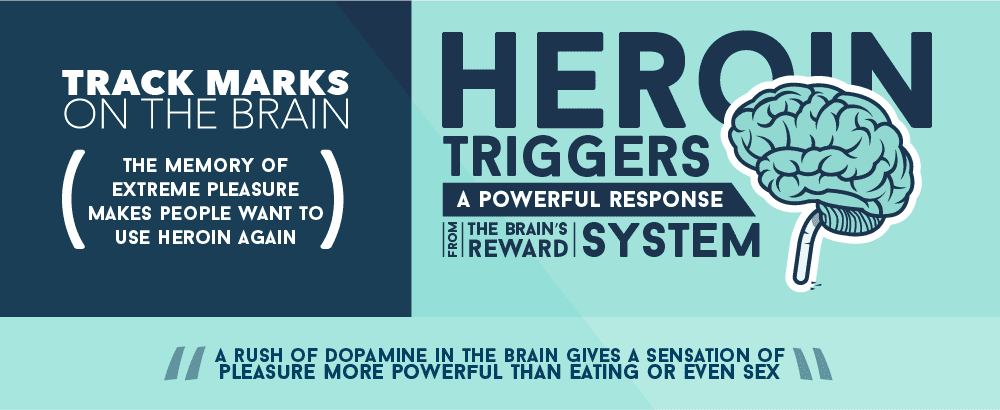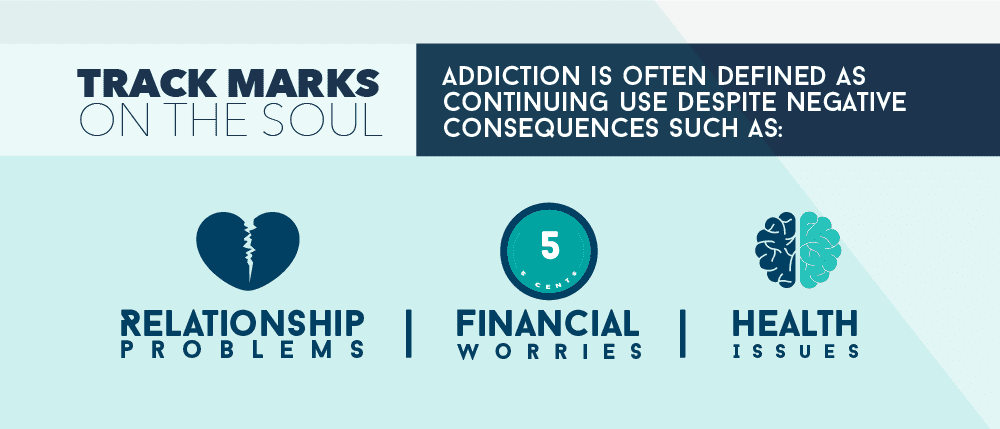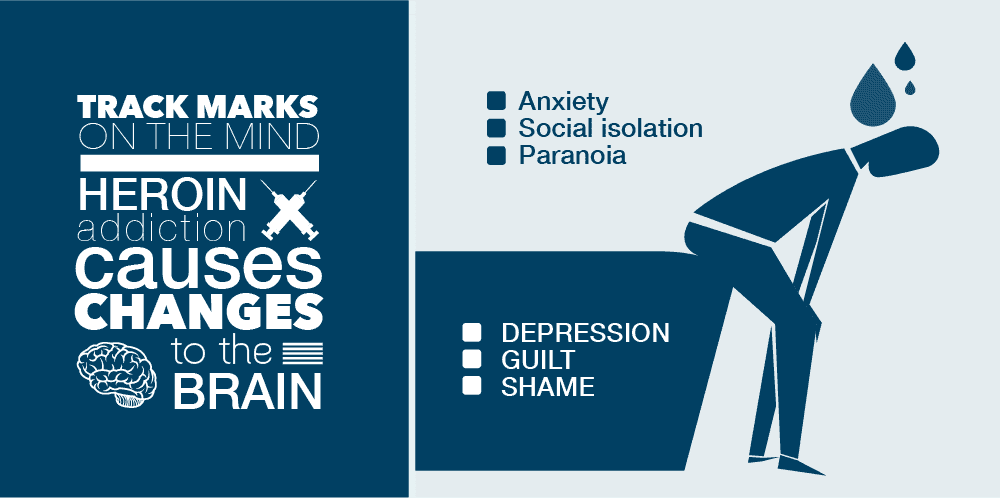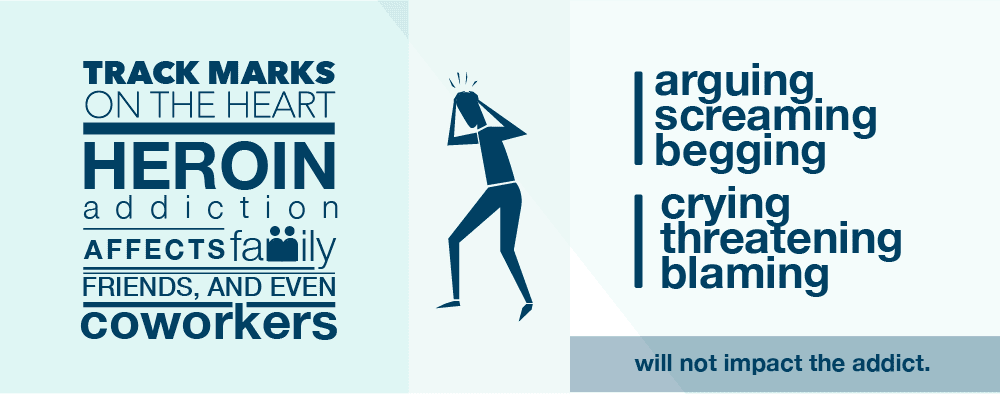“That’s when I saw the track marks. They ate away like a cancer at the time of her elbows and the backs of her hands…they were covered with the needle scars of an addict.” ~ Deborah Spungen, And I Don’t Want to Live This Life: A Mother’s Story of Her Daughter’s Murder Heroin addiction is making a comeback in this country, even if it never really went away. 2017 is on a record pace to see 71,600 overdose deaths in America – the most ever recorded in a single year. In fact, for the last few years, EVERY subsequent year has been a record year for fatal overdoses. For example, in 2014, there were “only” 47,055 drug deaths. But then, in 2015, it was 52,404. In 2016, the number of deaths spiked 22%, rising to an estimated 64,000. You guessed it – that is a record for a single-year increase. Doing the math, that is 52% more lost lives than there were just three years ago. This is why President Donald Trump has labeled the situation “the worst drug crisis in American history.”
Heroin Abuse in the United States (Track Marks on the Country)
“We are seeing an unbelievably sad and extensive heroin epidemic, and there is no end in sight. We are not, in 2017, anywhere close to the top of this thing. Heroin has a life force of its own.” ~ Dr. Daniel Ciccarone, the University of California at San Francisco You probably know that this tragedy is being driven by the ongoing opioid epidemic. After all, two-thirds of all overdose deaths involve an opioid. But what you may not know is that heroin abuse in this country is skyrocketing. Per the latest from the American Society of Addiction Medicine, nearly 600,000 Americans have a Substance Use Disorder (SUD) involving heroin. In 2007, there were “only” 153,000. Other statistics:
- As of 2014, there were approximately 1 MILLION regular heroin users in the United States.
- That is TRIPLE the number of heroin users in 2003.
- 2002-2016, the number of overdose deaths involving heroin increased by 739%.
- There were 15,546 heroin-involved fatalities in 2016.
- In 2013, there were “only” about 8200.
- 80% of heroin addicts started out by misusing prescription opioids such as:
- 94% of opioid rehab patients report switching to heroin because prescription painkillers were “far more expensive and harder to obtain.”
- 23% of people who even try heroin will eventually become addicted.
- In some parts of the country, to 44% of arrestees list heroin as their primary drug of choice.
- From 2015 to 2016, the amount of heroin and morphine seized in North America increased by 21%.
The Global Heroin Problem (Track Marks on the World)
In fact, the heroin trade is booming EVERYWHERE The United Nations Office on Drugs and Crime’s 2017 World Drug Report reports that there were 448 tons of heroin produced globally in 2016, a 34% increase from the previous year. This comes after the 2016 WDR said that heroin was the most dangerous drug worldwide. Around the world, approximately 53 MILLION people have misused an opioid within the past year. Between 2016 and 2017, opium production in Afghanistan increased 87%. That’s not surprising, because two-thirds of the global land devoted to illicit opium cultivation is in Afghanistan. Opium is a precursor ingredient to heroin and many other opioids. However, Mexico has now become a major player. Mexico has the third-greatest total land area for opium poppy cultivation. Now, 79% of all seized heroin samples in the United States originate in Mexico.
Why is Heroin So Addictive? (Track Marks in the Brain)
When heroin and other drugs of abuse are consumed, they trigger a strong response from the brain’s reward system. The biggest response is a surge in the production of dopamine – the neurotransmitter associated with feelings of pleasure. This flood of dopamine within the brain elicits more pleasure than other such survival-focused activity as eating or even sex. Moreover, this response, hits far faster and last much longer. The “rush” from shooting up heroin can kick in in as little as 10 seconds and last up to 5 hours. Dopamine is also associated with learning and memory. From the very first initiation, users learn that nothing else they do feels as good as heroin. It is the memory of those sensations that makes them want to use heroin again. This is early during their relationship with heroin, when recreational use is still a choice. However, over time and with repeated use, the brain’s reward circuitry becomes exhausted because of constant artificial over-stimulation. To compensate, the brain reduces the dopamine response. This is why heroin addicts must take ever-increasing amounts in order to get a response, even though that response is likewise diminishing. This is known as a drug tolerance. But as the heroin abuser’s dopamine response dwindles, so does their ability to enjoy the same things as healthy, non-addicted people. They lose interest in relationships, hobbies, and obligations. The only way for them to feel pleasure or even a semblance of normalcy is through heroin use. They once used heroin to feel good. Now, they use it to keep from feeling bad. This is known as a drug dependence. And when the drug isn’t available, or they try to quit, their heroin-accustomed brain responds by triggering harshly-unpleasant withdrawal symptoms, often leading to relapse.
Heroin Addiction (Track Marks on the Soul)
“I used to think a drug addict was someone who lived on the far edges of society. Wild-eyed, shaven-headed and living in a filthy squat. That was until I became one…” ~ Cathryn Kemp, Painkiller Addict: From Wreckage to Redemption – My True Story Heroin addiction is not the same as a recreational heroin use. The terms “use” and even “abuse” describe the action, but “addiction” goes much deeper than that. By this point, the choice to use heroin recreationally is gone. Now, the heroin addict uses because it’s too painful NOT to. Their actions are determined by their addiction. NOTHING else matters, even as the addiction causes:
- Relationship problems
- Difficulties at work or school
- Financial worries
- Legal complications
- Health Issues
One of the defining characteristics of an addiction is continuing use despite negative consequences. In other words, a heroin addict who is desperate enough will lie, break promises, steal, disregard the law, and hurt others and themselves as long as it allows them to procure and use more drugs. Even an accidental overdose may not be enough to get through to a person lost to active heroin addiction. The average heroin addict in recovery will relapse 8 to 10 times before maintaining sobriety.
Physical Effects of Heroin Abuse (Track Marks on the Arm…and Legs…and Everywhere Else)
“She was also a heroin addict. She shot drugs whenever there was a free opportunity and an available vein.” ~ Angela Davis, Restoration: Revolving Doors Heroin addiction is a disease that destroys the user’s body over time. Most of the physical damage doesn’t come from the drug itself, but from a weakened immune system combined with terrible self-neglect and poor self-care:
- Track mark scars—These form when the addict keeps shooting up at the same IV injection sites. When fresh, these will be raw or bloody inflamed areas. Older track marks will be calloused and discolored.
- Track marks on arms are the most common, usually found in the crook of the elbow. This is where most new users learn how to inject heroin.
- Alternate IV injection sites may be found on the wrist or on the back of the user’s hands.
- Track marks on legs are most often found on the inner thigh.
- Some users will also inject heroin into large veins on their feet or on the backs of their legs.
- Between the toes is a favorite spot of people trying to hide their heroin addiction.
- When they run out of other options, some heroin addicts will go so far as to inject the drug into their neck, breasts, or penis.
- Abscesses at the IV injection site – Heroin addicts have notoriously poor personal hygiene, so a needle puncture can easily become infected.
- Constipation
- Compromised immune system
- Muscular weakness
- Impotence
- Inability to achieve orgasm
- Menstruation problems
- Loss of appetite
- Malnutrition
- Inflamed gums
- Dental problems
- Breathing difficulties
- HIV/AIDS
- Hepatitis
Psychological Effects of Heroin Abuse (Track Marks on the Mind)
“Heroin gave me wings, but took away the sky.” ~ Drew Gates, The Crooked Beat Chronic heroin abuse can also take a tremendous toll on the user’s state of mind. Slowly but surely, addiction, dishonesty, denial, deception, and dysfunction warp the person’s personality until they scarcely resemble who they once were. Again, this is NOT a choice. Heroin abuse causes physical and chemical changes to the brain.
- White matter deficits
- Decreased gray matter density
- Cognitive difficulty
- Memory impairment
- Anxiety
- Depression
- Social isolation
- Paranoia
- Guilt
- Shame
The Effect of Heroin on Relationships (Track Marks on the Heart)
“Don’t ever think you’re better than a drug addict, because your brain works the same as theirs. You have the same circuits. And drugs would affect your brain in the same way it affects theirs.” ~ Oliver Markus, Sex and Crime: Oliver’s Strange Journey Addiction is a disease and a paradox. It is a lonely and isolating disease that somehow affects everyone around the addict—family, friends, and even coworkers. And because of that, every positive relationship is negatively impacted. It’s strange, because the people closest to the addict—those that truly care the most—are the ones who are hurt the most. And because of their concern, they are also the ones who end up in the most conflict with the substance abuser. But here’s the thing—a heroin addict is both mentally and physically unwell, and no amount of logic, arguing, screaming, begging, crying, threatening, or blaming will have any impact on their disease.
Heroin Withdrawal (Track Marks on the Will)
“The whole body just sort of turns itself inside out and rejects itself for three days. You know in three days it’s going to calm down. It’s going to be the longest three days you’ve spent in your life… Your skin crawling, your guts churning, you can’t stop your limbs from jerking and moving about, and you’re throwing up…” ~ Keith Richards, Life Heroin withdrawal is the Hell that heroin addicts without heroin go through. Even the English-language has changed to try to accurately portray what giving up heroin is like. Quitting something “cold turkey” refers to the skin of someone in heroin withdrawal. One of the symptoms is uncontrollable chills, resulting in goose pimples that resemble the skin of a plucked, cold turkey. “Kicking the habit” describes the muscular spasms of a heroin addict in withdrawal. Someone who is experiencing the flu-like symptoms of heroin withdrawal is referred to as “dope sick”. Heroin withdrawal can commence in as little as 8 hours after the last use. Symptoms include: Mild symptoms:
- Nausea
- Vomiting
- Abdominal cramps
- Runny nose
- Teary eyes
- Chills
- Profuse sweating
- Uncontrollable yawning
- Muscle aches
- Joint pain
Moderate symptoms:
- Copious vomiting
- Explosive diarrhea
- Goosebumps
- Agitation
- Extreme restlessness
- Inability to concentrate
- Overwhelming fatigue
- Hand tremors
Severe symptoms:
- Anxiety, often to the point of panic
- Severe depression
- Inability to feel pleasure
- Strong, irresistible drug cravings
- Insomnia
- Rapid heartbeat
- Elevated blood pressure
- Breathing difficulties
- Painful muscle spasms
- Dehydration
These symptoms tend to peak within the first 72 hours and typically last 10-14 days. Heroin withdrawal is not life-threatening, but it can be so painful that the addict would rather resume drug use than continue enduring withdrawal.
Heroin Overdose (Track Marks to the Grave)
“You know, once you go down that road of– of taking — heroin — I mean, ever turning back, obviously, is almost impossible for so many people. And it took us– it took me, you know, way too long to — to figure that out.” ~ Gilbert Freeman, who lost his two youngest sons to heroin overdose—on Valentine’s Day and Mother’s Day Like other opioids, heroin kills by respiratory depression. During an overdose, the user “forgets” to breathe. Here’s the terrifying part—there’s no way for a heroin addict to know if his next shot will be the last. Every batch of heroin is different, both in purity and potency. A person can shoot up their accustomed amount, only to overdose because it was two…or five…or ten times stronger than what they are used to. And there’s no easy way to tell the difference. Even worse, some suppliers are boosting their product’s potency by mixing in or even substituting fentanyl for the heroin. Fentanyl is a powerful synthetic opioid that is 50 times stronger than heroin. An amount as small as six grains of salt can be fatal. In 2016, fentanyl-involved deaths mushroomed to over 21,000, surpassing heroin for the first time. Heroin and fentanyl are identical in appearance. Even more frightening, some designer multi-opioid combinations might include heroin, fentanyl, and even carfentanil—an animal tranquilizer 10,000 times more potent than morphine. These drugs are so deadly that it may take multiple administrations of emergency anti-overdose medications to save the victim’s life.
Surviving a Heroin Overdose (Back-Tracking)
“I didn’t know about naloxone. At the time, we couldn’t carry it in our homes, and I lived in fear on every day. If you have asthma, you take an asthma inhaler. If you have an allergy, you carry an EpiPen. People around you know how to do it. Naloxone should be the same way.” ~ Shawn Norton, GRASP—Grief After Substance Passing Because of the rise in overdose deaths, many first responders are now issued Narcan, an emergency medication that can reverse an overdose as it’s happening. Narcan is a nasal spray formulation of the drug naloxone, a powerful opioid antagonist—a substance that binds to specific receptors within the brain and blocks or reverses the effects of opioid drugs. During an overdose, naloxone helps restore normal breathing. One of the main benefits to naloxone as formulated in Narcan is its ease of use. Simply place the nozzle into the nostrils of the overdose victim and firmly press the plunger. After the victim is revived, they will still need to seek emergency medical attention. Narcan is now available in pharmacies nationwide, often without a prescription.
Recovery from Heroin Addiction (Back on Track)
There IS good news—people CAN and DO recover from heroin addiction. Research has shown that the best treatment model is focused on abstinence, using a combination of behavioral counseling and Medication-Assisted Treatment. MAT drugs are safer alternatives to heroin:
- Methadone
Pros:
* Long history as a treatment
* Inexpensive
Cons:
* Addictive
* Is not abstinence-focused
* Requires daily trips to a clinic
- Suboxone
Pros:
* Once-a-day pill
* Inexpensive
Cons:
* Can be misused
* Not abstinence-focused
- Vivitrol
Pros:
* Once-a-month shot
* Non-addictive
* Does not produce a high
Cons:
* Much more expensive than other MAT drugs
* Patient must detox from all opioids first
The best news is that when the right medications are used in combination with other evidence-based treatment strategies, up to 85% of people in rehab successfully complete the program. The sad part is that although these treatments are available—and in most cases, covered by insurance—nearly 90% of people who need help for an addictive disorder are actually receiving treatment. What does all this mean? It means that is you or someone you care about is abusing heroin or any other opioid, the time to get professional specialized care is NOW. Heroin addiction never gets better on its own.
What Did you Think About This Blog?
Give it a Rating!

